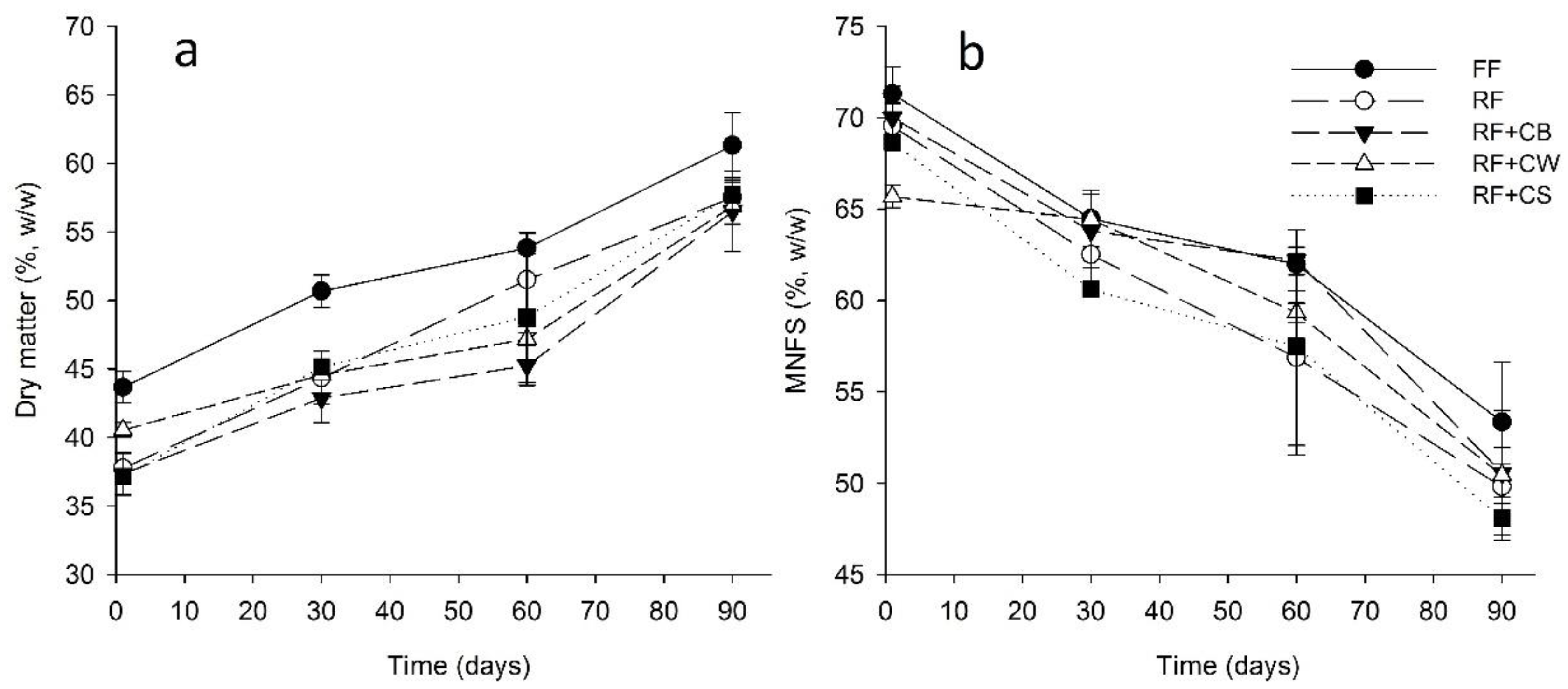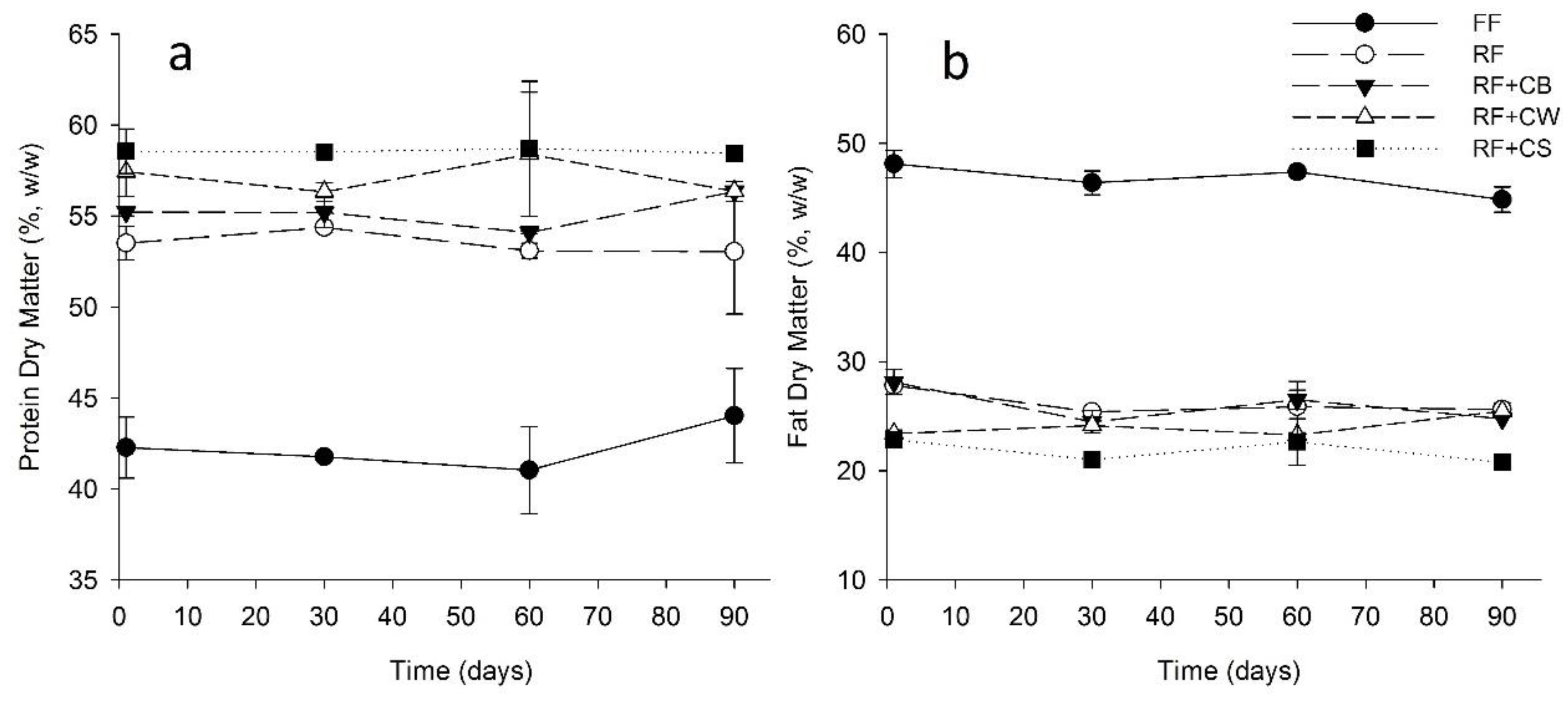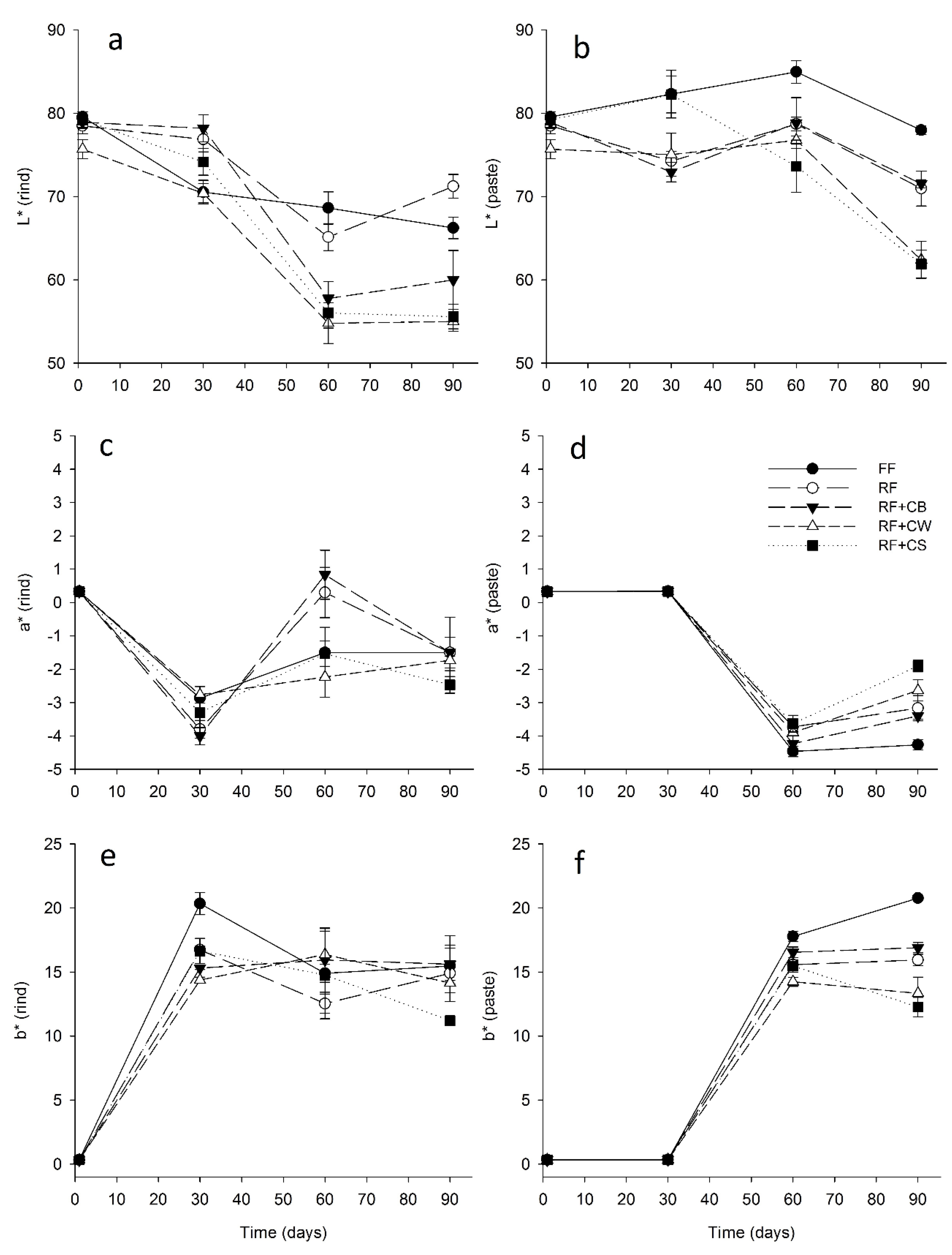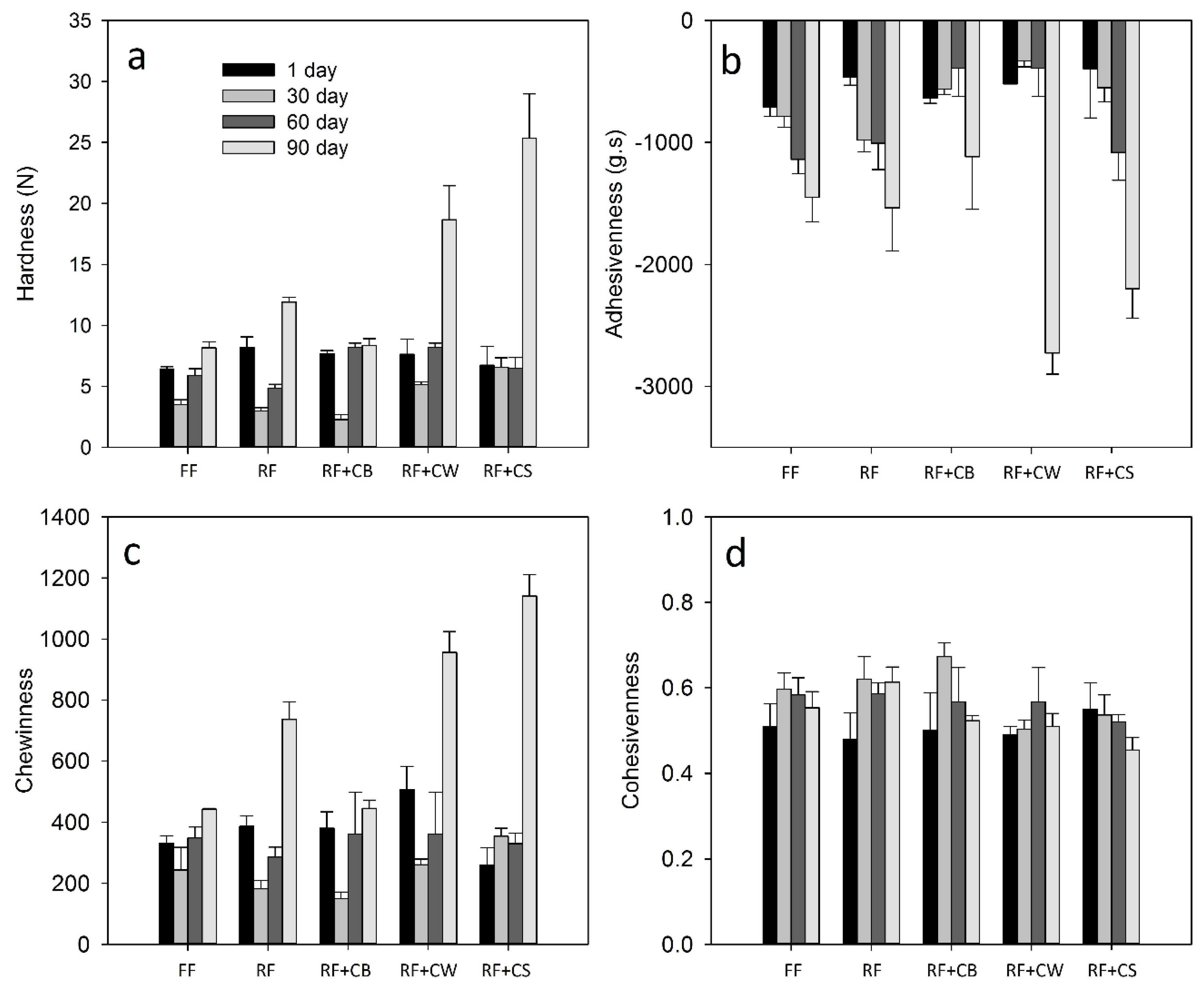Dairy by-Products Concentrated by Ultrafiltration Used as Ingredients in the Production of Reduced Fat Washed Curd Cheese
Abstract
1. Introduction
Strategies to Improve the Characteristics of RF/LF Cheeses
2. Materials and Methods
3. Results and Discussion
4. Conclusions
Author Contributions
Funding
Acknowledgments
Conflicts of Interest
References
- Rogers, N.R.; Drake, M.A.; Daubert, C.R.; Mcmahon, D.J.; Bletsch, T.K.; Foegeding, E.A. The effect of aging on low-fat, reduced-fat, and full-fat Cheddar cheese texture. J. Dairy Sci. 2009, 92, 4756–4772. [Google Scholar] [CrossRef] [PubMed]
- Zalazar, C.A.; Zalazar, C.S.; Bernal, S.; Bertola, N.; Bevilacqua, A.; Zraitzky, N. Effect of moisture level and fat replacer on physico-chemical, rheological and sensory properties of low fat soft cheeses. Int. Dairy J. 2002, 12, 45–50. [Google Scholar] [CrossRef]
- McCarthy, C.M.; Wilkinson, M.G.; Kelly, P.M.; Guinee, T.P. Effect of salt and fat reduction on proteolysis, rheology and cooking properties of Cheddar cheese. Int. Dairy J. 2016, 56, 74–86. [Google Scholar] [CrossRef]
- Banks, J.M. The technology of low-fat cheese manufacture. Int. J. Dairy Technol. 2004, 57, 199–208. [Google Scholar] [CrossRef]
- Drake, M.A.; Miracle, R.E.; Mcmahon, D.J. Impact of fat reduction on flavour and flavour chemistry of Cheddar cheeses. J. Dairy Sci. 2010, 93, 5069–5081. [Google Scholar] [CrossRef]
- Rogers, N.R.; McMahon, D.J.; Daubert, C.R.; Berry, T.K.; Foegeding, E.A. Rheological properties and microstructure of Cheddar cheese made with different fat contents. J. Dairy Sci. 2010, 93, 4565–4576. [Google Scholar] [CrossRef]
- Mistry, V.V. Low fat cheese technology. Int. Dairy J. 2001, 11, 413–422. [Google Scholar] [CrossRef]
- Mayta-Hancco, J.; Trujillo, A.J.; Zamora, A.; Juan, B. Effect of ultra-high pressure homogenisation of cream on the physicochemical and sensorial characteristics of fat-reduced starter-free fresh cheeses. LWT Food Sci. Technol. 2019, 110, 292–298. [Google Scholar] [CrossRef]
- Di Cagno, R.; De Pasquale, I.; De Angelis, M.; Buchin, S.; Rizzello, C.G.; Gobbetti, M. Use of microparticulate whey protein concentrate, exopolysaccharide-producing Streptococcus thermophilus, and adjunct cultures for making low-fat Italian Caciotta-type cheese. J. Dairy Sci. 2014, 97, 72–84. [Google Scholar] [CrossRef] [PubMed]
- Oluk, A.C.; Güven, M.; Hayaloglu, A.A. Proteolysis texture and microstructure of low-fat Tulum cheese affected by exopolysaccharide-producing cultures during ripening. Int. J. Food Sci. Technol. 2014, 49, 435–443. [Google Scholar] [CrossRef]
- Oluk, A.C.; Güven, M.; Hayaloglu, A.A. Influence of exopolysaccharide-producing cultures on the volatile profile and sensory quality of low-fat Tulum cheese. Int. J. Dairy Technol. 2014, 67, 265–276. [Google Scholar] [CrossRef]
- Koca, N.; Metin, M. Textural, melting and sensory properties of low-fat fresh Kashar cheeses produced by using fat replacers. Int. Dairy J. 2004, 14, 365–373. [Google Scholar] [CrossRef]
- Lashkari, H.; Khosrowshahi, A. Chemical composition and rheology of low-fat Iranian white cheese incorporated with guar gum and gum arabic as fat replacers. J. Food Sci. Technol. 2014, 51, 2584–2591. [Google Scholar] [CrossRef]
- Diamantino, V.R.; Beraldo, F.A.; Sunakozawa, T.N.; Lúcia, A.; Penna, B. Effect of octenyl succinylated waxy starch as a fat mimetic on texture, microstructure and physicochemical properties of Minas fresh cheese. LWT Food Sci. Technol. 2014, 56, 356–362. [Google Scholar] [CrossRef]
- Wydrych, J.; Gawron, A.; Jeli, T. The effect of fat replacement by inulin on the physicochemical properties and microstructure of acid casein processed cheese analogues with added whey protein polymers. Food Hydrocoll. 2015, 44, 1–11. [Google Scholar] [CrossRef]
- Wang, F.; Tong, Q.; Luo, J.; Xu, Y.; Ren, F. Effect of carrageenan on physicochemical and functional properties of low-fat Colby cheese. J. Food Sci. 2016, E1949–E1955. [Google Scholar] [CrossRef]
- Palatnik, D.R.; Herrera, P.A.; Rinaldoni, A.N.; Basurto, R.O.; Campderrós, M.E. Development of reduced-fat cheeses with the addition of Agave fructans. Int. J. Dairy Technol. 2016, 70, 212–219. [Google Scholar] [CrossRef]
- Dai, S.; Jiang, F.; Corke, H.; Shah, N.P. Physicochemical and textural properties of mozzarella cheese made with konjac glucomannan as a fat replacer. Food Res. Int. 2018, 107, 691–699. [Google Scholar] [CrossRef]
- Sharma-Khanal, B.K.; Bhandari, B.; Prakash, S.; Liu, D.; Zhou, P.; Bansal, N. Modifying textural and microstructural properties of low fat Cheddar cheese using sodium alginate. Food Hydrocoll. 2018, 83, 97–108. [Google Scholar] [CrossRef]
- Li, H.; Liu, Y.; Sun, Y.; Li, H.; Yu, J. Properties of polysaccharides and glutamine transaminase used in mozzarella cheese as texturizer and crosslinking agents. LWT Food Sci. Technol. 2019, 99, 411–416. [Google Scholar] [CrossRef]
- Torres, I.C.; Mutaf, G.; Larsen, F.H.; Ipsen, R. Effect of hydration of microparticulated whey protein ingredients on their gelling behaviour in a non-fat milk system. J. Food Eng. 2016, 184, 31–37. [Google Scholar] [CrossRef]
- Zhang, Z.; Arrighi, V.; Campbell, L.; Lonchamp, J. Properties of partially denatured whey protein products: Formation and characterisation of structure. Food Hydrocoll. 2016, 52, 95–105. [Google Scholar] [CrossRef]
- Cheftel, J.C.; Dumay, E. Microcoagulation of proteins for development of creaminess. Food Rev. Int. 1993, 9, 473–502. [Google Scholar] [CrossRef]
- Liu, K.; Stieger, M.; Van der Linden, E.; Van de Velde, F. Effect of microparticulated whey protein on sensory properties of liquid and semi-solid model foods. Food Hydrocoll. 2016, 60, 186–198. [Google Scholar] [CrossRef]
- Henriques, M.; Gomes, D.; Brennan, K.; Skryplonek, K.; Fonseca, C.; Pereira, C. The use of whey proteins as fat replacers for the production of reduced fat cheeses. In Cheese Production, Consumption and Health Benefits; Henriques, M., Pereira, C., Eds.; Nova Science Publishers: New York, NY, USA, 2018; pp. 139–168. [Google Scholar]
- Hinrichs, J. Incorporation of whey proteins in cheese. Int. Dairy J. 2001, 11, 495–503. [Google Scholar] [CrossRef]
- Frusch, J.A.H.; Kokx, J.J.M.P. Cheese with Added Whey Protein Agglomerates. European Patent Application EP1917861 A1, 7 May 2008. [Google Scholar]
- Giroux, H.J.; Veilllete, N.; Britten, M. Use of denatured whey protein in the production of artisanal cheeses from cow, goat and sheep milk. Small Rum. Res. 2018, 161, 34–42. [Google Scholar] [CrossRef]
- AOAC. AOAC Official Methods of Analysis of Association of Official Analytical Chemists, 16th ed.; 33 Dairy Products; AOAC: Rockville, MD, USA, 1997; Volume II. [Google Scholar]
- ISO. ISO 3433 Cheese-Determination of Fat Content—Van Gulik Method; International Organization for Standardization: Geneva, Switzerland, 2008. [Google Scholar]
- IPQ. IPQ-Portuguese Institute of Quality (NP-1598)—Cheese: Definition, Classification, Packaging and Marking; IPQ: Lisbon, Portugal, 1983. [Google Scholar]
- Kavas, G.; Oysun, G.; Kinik, O.; Uysal, H. Effect of some fat replacers on chemical, physical and sensory attributes of low-fat white pickled cheese. Food Chem. 2004, 88, 381–388. [Google Scholar] [CrossRef]
- Skeie, S.; Alseth, G.M.; Østlie, H.; Abrahamsen, R.K.; Johansen, A.G.; Øyaas, J. Improvement of the quality of low-fat cheese using a two-step strategy. Int. Dairy J. 2013, 33, 153–162. [Google Scholar] [CrossRef]
- Stankey, J.A.; Lu, Y.; Abdalla, A.; Govindasamy-Lucey, S.; Jaeggi, J.J.; Mikkelsen, B.Ø.; Kenneth, T.; Pedersen, K.T.; Andersen, C.B. Low-fat Cheddar cheese made using microparticulated whey proteins: Effect on yield and cheese quality. Int. J. Dairy Technol. 2017, 70, 481–491. [Google Scholar] [CrossRef]
- Perreault, V.; Rémillard, N.; Chabot, D.; Morin, P.; Pouliot, Y.; Britten, M. Effect of denatured whey protein concentrate and its fractions on cheese composition and rheological properties. J. Dairy Sci. 2017, 100, 5139–5152. [Google Scholar] [CrossRef]
- Olivares, M.L.; Shahrivar, K.; de Vicente, J. Soft lubrication characteristics of microparticulated whey proteins used as fat replacers in dairy systems. J. Food Eng. 2019, 245, 157–165. [Google Scholar] [CrossRef]
- Romeih, E.A.; Moe, K.M.; Skeie, S. The influence of fat globule membrane material on the microstructure of low-fat Cheddar cheese. Int. Dairy J. 2012, 26, 66–72. [Google Scholar] [CrossRef]
- Bahrami, M.; Ahmadi, D.; Beigmohammadi, F.; Hosseini, F. Mixing sweet cream buttermilk with whole milk to produce cream cheese. Irish J. Agric. Food Res. 2015, 54, 73–78. [Google Scholar] [CrossRef][Green Version]
- Hickey, C.D.; Diehl, B.W.K.; Nuzzo, M.; Millqvist-Feurby, A.; Wilkinson, M.G.; Sheehan, J.J. Influence of buttermilk powder or buttermilk addition on phospholipid content, chemical and bio-chemical composition and bacterial viability in Cheddar style cheese. Food Res. Int. 2017, 102, 748–758. [Google Scholar] [CrossRef]
- Hickey, C.D.; O’Sullivan, M.G.; Davis, J.; Scholz, D.; Kilcawley, K.N.; Wilkinson, M.G.; Sheehan, J.J. The effect of buttermilk or buttermilk powder addition on functionality, textural, sensory and volatile characteristics of Cheddar-style cheese. Food Res. Int. 2018, 103, 468–477. [Google Scholar] [CrossRef]






| Ingredients | Dry Matter | Protein | Fat | Ash |
|---|---|---|---|---|
| CB | 13.78 a ± 0.42 | 3.65 a ± 0.07 | 1.41 a ± 0.01 | 0.75 a ± 0.09 |
| CW | 13.19 a ± 0.68 | 5.49 b ± 0.04 | 2.81 b ± 0.01 | 0.92 b ± 0.03 |
| CS | 10.35 b ± 0.14 | 6.56 c ± 0.05 | 0.41 c ± 0.01 | 0.54 c ± 0.02 |
| Milk Batches | DM | F | P | L 1 | A |
|---|---|---|---|---|---|
| FFM | 11.45 a ± 0.04 | 3.35 a ± 0.01 | 3.04 a ± 0.02 | 4.40 a ± 0.03 | 0.66 a ± 0.00 |
| RFM | 9.91 b ± 0.08 | 1.41 b ± 0.03 | 3.18 b ± 0.02 | 4.63 b ± 0.03 | 0.69 b ± 0.00 |
| RFM + CB | 10.03 b ± 0.04 | 1.43 b ± 0.02 | 3.22 b ± 0.01 | 4.68 b ± 0.02 | 0.70 b ± 0.00 |
| RFM + CW | 9.63 c ± 0.16 | 1.17 c ± 0.03 | 3.17 b ± 0.05 | 4.61 b ± 0.07 | 0.69 b ± 0.01 |
| RFM + CS | 9.84 bc ± 0.14 | 1.22 bc ± 0.05 | 3.23 b ± 0.03 | 4.69 b ± 0.05 | 0.70 b ± 0.01 |
| Cheese | AP 30 | AR 30 | TE 30 | TA 30 |
|---|---|---|---|---|
| FF | 7.00 a ± 1.17 | 6.63 ab ± 1.85 | 7.03 a ± 1.22 | 7.23 a ± 1.63 |
| RF | 7.10 a ± 1.71 | 6.63 ab ± 1.56 | 6.67 ab ± 1.73 | 6.57 ab ± 1.83 |
| RF + CB | 7.50 a ± 1.17 | 6.87 a ± 1.38 | 7.33 a ± 1.49 | 7.27 a ± 1.26 |
| RF + CW | 6.80 a ± 1.65 | 6.00 ab ± 1.60 | 5.77 b ± 1.45 | 5.73 b ± 1.98 |
| RF + CS | 6.63 a ± 1.50 | 5.73 b ± 1.48 | 5.57 b ± 1.65 | 5.57 b ± 1.94 |
| AP 60 | AR 60 | TE 60 | TA 60 | |
| FF | 7.53 a ± 1.20 | 7.23 a ± 1.10 | 7.53 ab ± 1.20 | 7.50 a ± 1.28 |
| RF | 7.30 a ± 0.95 | 6.70 a ± 1.42 | 7.40 ab ± 1.35 | 7.27 ab ± 1.55 |
| RF + CB | 7.53 a ± 0.94 | 7.03 a ± 1.19 | 7.67 a ± 1.18 | 7.10 ab ± 1.27 |
| RF + CW | 7.23 a ± 1.04 | 6.77 a ± 1.38 | 7.00 ab ± 1.39 | 6.90 ab ± 1.32 |
| RF + CS | 7.20 a ± 1.19 | 6.60 a ± 1.48 | 6.63 b ± 1.73 | 6.43 b ± 1.89 |
| AP 90 | AR 90 | TE 90 | TA 90 | |
| FF | 7.77 a ± 1.28 | 7.13 a ± 1.61 | 7.37 a ± 1.69 | 7.50 a ± 1.59 |
| RF | 7.40 ab ± 1.04 | 6.70 a ± 1.58 | 6.90 ab ± 1.54 | 6.93 ab ± 1.53 |
| RF + CB | 7.43 ab ± 0.94 | 6.90 a ± 1.40 | 6.97 ab ± 1.63 | 7.00 ab ± 1.51 |
| RF + CW | 5.93 b ± 1.66 | 6.17 a ± 2.02 | 6.00 b ± 1.82 | 6.33 b ± 1.63 |
| RF + CS | 6.77 ab ± 1.36 | 6.10 a ± 1.90 | 6.63 ab ± 1.52 | 6.63 ab ± 1.52 |
| Cheese | Rank 30 | Rank 60 | Rank 90 |
|---|---|---|---|
| FF | 2.23 a ± 1.30 | 2.23 a ±1.22 | 2.17 a ± 1.49 |
| RF | 2.80 a ± 1.32 | 2.97 ab ± 1.30 | 2.60 ab ± 1.35 |
| RF + CB | 2.23 a ±1.07 | 2.60 ab ± 1.28 | 2.90 ab ± 1.18 |
| RF + CW | 3.83 b ± 1.23 | 3.50 b ± 1.46 | 3.87 b ± 1.31 |
| RF + CS | 3.90 b ± 1.18 | 3.70 b ± 1.37 | 3.47 b ± 1.14 |
© 2020 by the authors. Licensee MDPI, Basel, Switzerland. This article is an open access article distributed under the terms and conditions of the Creative Commons Attribution (CC BY) license (http://creativecommons.org/licenses/by/4.0/).
Share and Cite
Borges, A.R.; Pires, A.F.; Marnotes, N.G.; Gomes, D.G.; Henriques, M.F.; Pereira, C.D. Dairy by-Products Concentrated by Ultrafiltration Used as Ingredients in the Production of Reduced Fat Washed Curd Cheese. Foods 2020, 9, 1020. https://doi.org/10.3390/foods9081020
Borges AR, Pires AF, Marnotes NG, Gomes DG, Henriques MF, Pereira CD. Dairy by-Products Concentrated by Ultrafiltration Used as Ingredients in the Production of Reduced Fat Washed Curd Cheese. Foods. 2020; 9(8):1020. https://doi.org/10.3390/foods9081020
Chicago/Turabian StyleBorges, Ana Raquel, Arona Figueiroa Pires, Natalí Garcia Marnotes, David Gama Gomes, Marta Fernandes Henriques, and Carlos Dias Pereira. 2020. "Dairy by-Products Concentrated by Ultrafiltration Used as Ingredients in the Production of Reduced Fat Washed Curd Cheese" Foods 9, no. 8: 1020. https://doi.org/10.3390/foods9081020
APA StyleBorges, A. R., Pires, A. F., Marnotes, N. G., Gomes, D. G., Henriques, M. F., & Pereira, C. D. (2020). Dairy by-Products Concentrated by Ultrafiltration Used as Ingredients in the Production of Reduced Fat Washed Curd Cheese. Foods, 9(8), 1020. https://doi.org/10.3390/foods9081020







